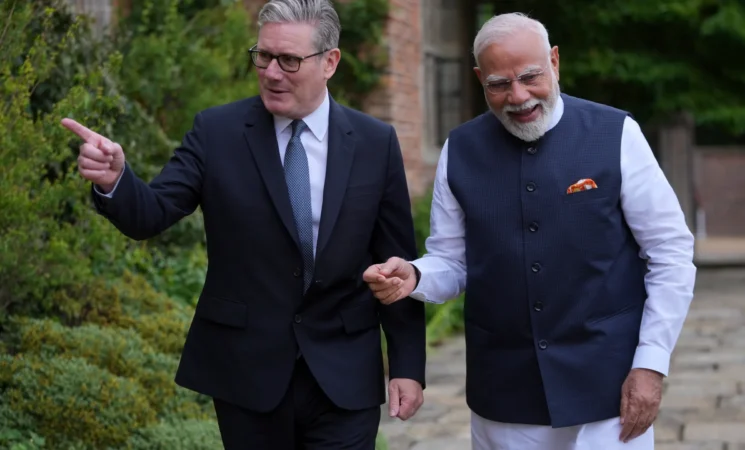25 July 2025, NIICE Commentary 11500
Dr Chander Shekhar
Indian Prime Minister completed his two-day visit to the United Kingdom. The visit was scheduled between 23 and 24 July. In history, this marks the start of a new historic chapter. During the visit, new commitments and a strategic vision were designed for the next 10 years. The trips concluded with the meetings with the UK Prime Minister, delegation-level talks in different sectoral areas of cooperation, engagement with the Indian diaspora and a meeting with King Charles III. In addition to the long-awaited bilateral trade agreement, which is known as the Comprehensive Economic and Trade Agreement (CETA), the two leaders have set the future strategic road map in the form of India-UK Vision 2035. This vision covers their vast engagement sectors and modalities in growth, technology and innovation, defence, security, climate change and clean energy, and the education sector. These have broadened their bilateral ambition and taken new heights to their Comprehensive Strategic Partnership commitments in a new era.
Mutual Respect and Benefits: CETA
Trade agreement is not an overnight phenomenon; it is concluded after several rounds of dialogue in various mechanisms. The misunderstanding and challenges are common in such dialogues, and the result is mutual payoffs after mutual compromise in engagement from both sides. Scarcity is the foundation of international trade and security. The trade talks were concluded in the month of May after three continuous years of negotiations in the shadow of trade wars and protectionism unleashed by the Trump administration.
The conclusion of the Comprehensive Economic and Trade Agreement (CETA) between the UK and India is a strategic endeavour. The Prime Ministers of the UK and India welcome the signing of the economic agreement, which will complement their Comprehensive Strategic Partnership to a new level while enhancing their trade, economic collaboration, job creation and others. In the words of the Indian Prime Minister, “this agreement is more than just an economic partnership; it is also a blueprint for shared prosperity and it paves the way for enhanced market access in the UK for Indian textiles, footwear, gems and jewellery, seafood, and engineering goods”. The agreement is seen as a milestone in Indian diplomacy with a major developed economy and a permanent member of the United Nations Security Council (UNSC). Currently, their bilateral trade volume stands at USD 56 billion, and is to be doubled by 2030.
The CETA has secured roughly 99% of duty-free access of India’s exports to the UK and is forecasted to open new opportunities in areas such as textiles, marine products, leather, footwear, and others, along with engineering goods, auto components and organic chemicals. It can also be said that the agreement is wide and inclusive, and would be beneficial to farmers, women, youth, Start-ups, MSMEs and others. There is no doubt that in the future, the agreement will have wide impacts on a resilient economic partnership between the two countries.
For the UK, it is the biggest trade deal ever existed with the European Union. Under this agreement, the British firms will have access to “India’s procurement market for products in sectors such as clean energy, and the trade deal also covers services sectors such as insurance”. However, analysts believe the trade deal could be an expensive one as far as public health is concerned. “It will allow tariff-free entry, and thus lower prices, for U.K.-made food products such as biscuits, chocolates and soft drinks in India, many of which would fit into the categorisation of high fat, sugar and salt (HFSS), posing grave long-term health risks.
India-UK Vision 2035: Outcomes
Bound by mutual respect and mutual learning, the relationship between the UK and India has entered a new era of practical cooperation, and managing issues that trigger conflicts has mutual collateral damage for the future. The UK PM Starmer had condemned the terror attacks in Jammu and Kashmir’s area of Pahalgam area. He says, “The horrific terrorist attack in Kashmir today is utterly devastating”.
The release of India-UK Vision 2035 is the product of their long commitments and resolve “to work together for mutual growth, prosperity and to shape a prosperous, secure and sustainable world in a time of rapid global change”. Both leaders believe that the India-UK Vision will create new objectives and renew partnership in the next 10 years in areas such as economy and growth, technology, innovation, research and education, defence and security, climate change, health and people-to-people ties. These pillars are designed in such a manner that they reinforce each other and shape future partnerships.
In the education sector, UK universities will set up their campuses in India as per the New Education Policy 2020. In this direction, the Southampton University shall open its first foreign campus in Gurugram, Liverpool in Bengaluru and York, Aberdeen, and Bristol plans to establish a presence. Under Vision 2035, this collaboration will cement their educational and research collaboration to a new height.
In the defence and security area, both agree to strengthen defence collaboration by creating a 10-year defence industrial roadmap and other mechanisms for implementation, such as the Electric Propulsion Capability Partnership (EPCP) and Jet Engine Advanced Core Technologies (JEACT). In the Indo-Pacific region, the cooperation through the establishment of the Regional Maritime Security Centre of Excellence (RMSCE) is a strategic posturing to build capacity and resilience in the non-traditional security threats across the Indian Ocean.
Conclusion
The UK and India, besides their colonial past, have set the tone of their future course of action as part of India-UN Vision 2035. This vision document is inclusive and dynamic. Along with the trade agreement, which opens new doors of opportunities, it could be a historic moment if implemented well, while affecting fewer people in terms of public health. The defence collaboration would achieve India’s aspiration to become Atma Nirbhar or self-reliant in the manufacturing sector. Among others, the educational cooperation could be a booster in fixing misunderstandings.
Dr Chander Shekhar is a Researcher and Author at the Centre for International Politics, Organizations and Disarmament, Jawaharlal Nehru University, New Delhi, India.

